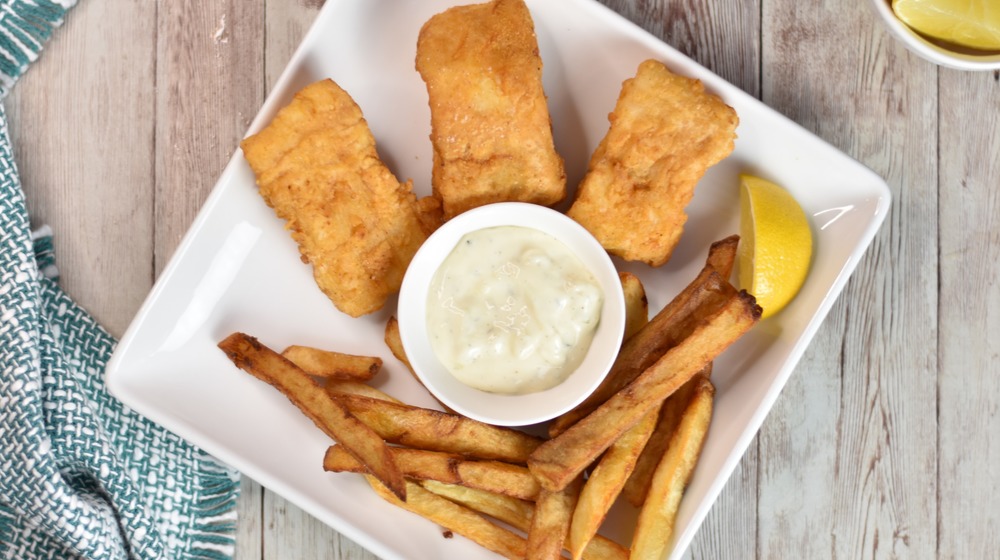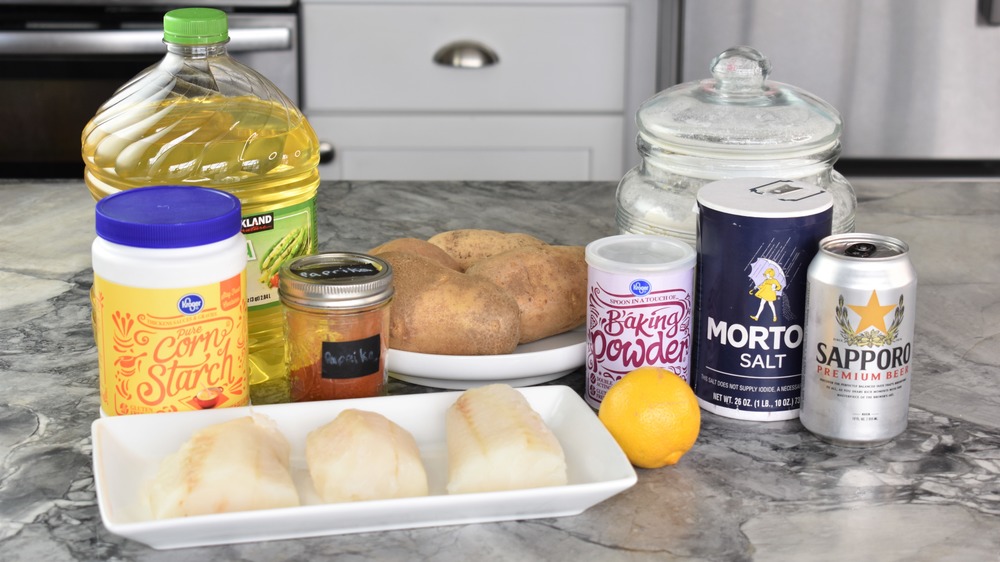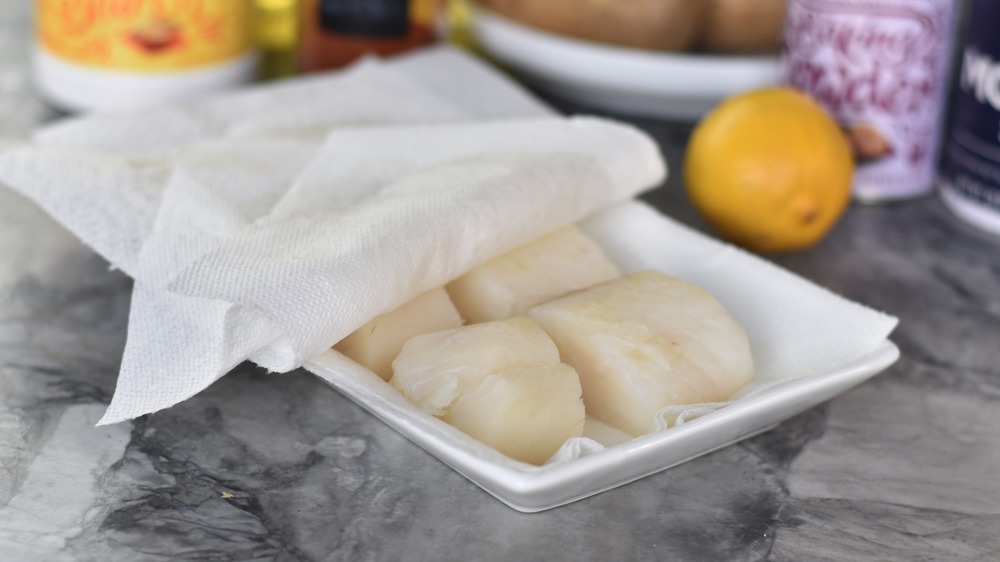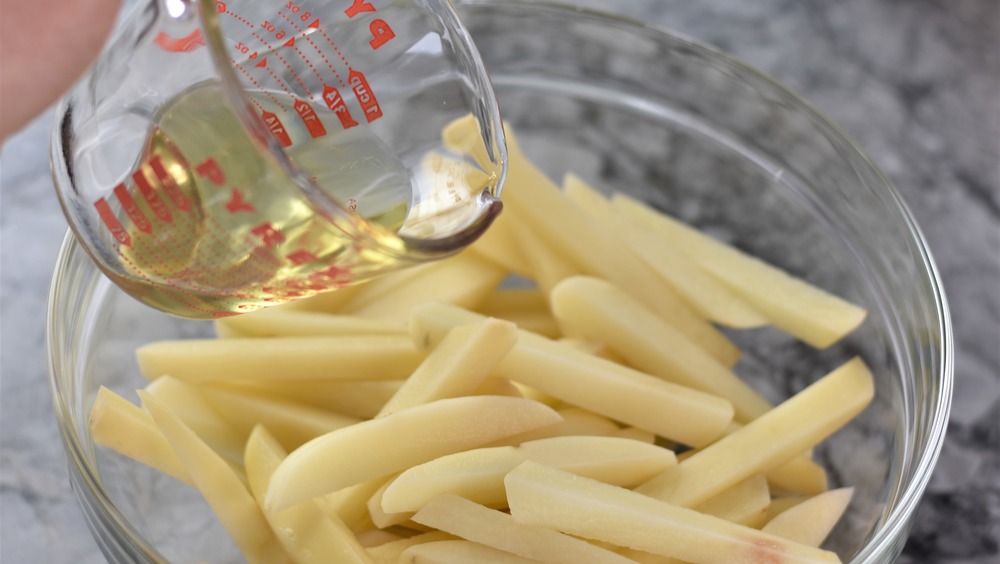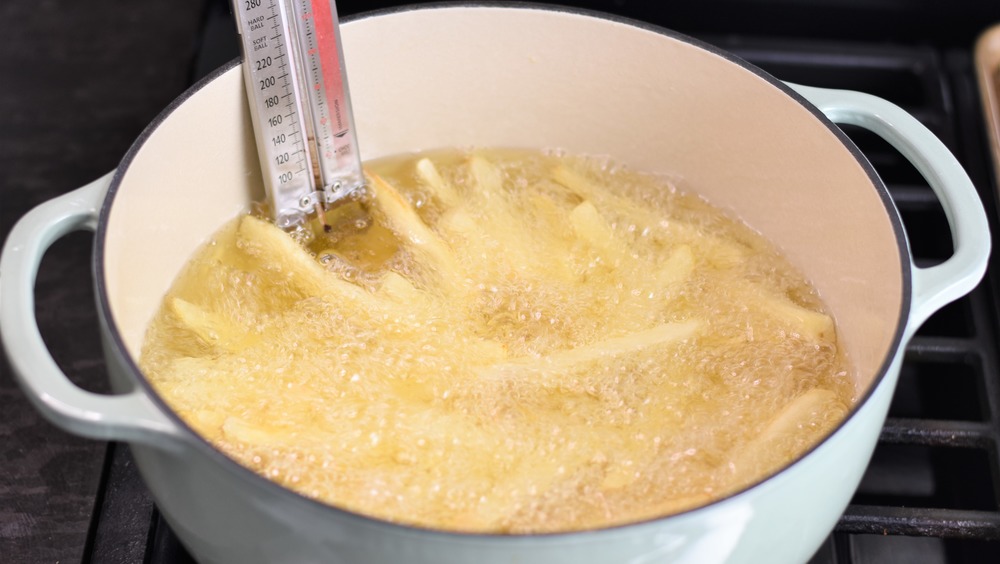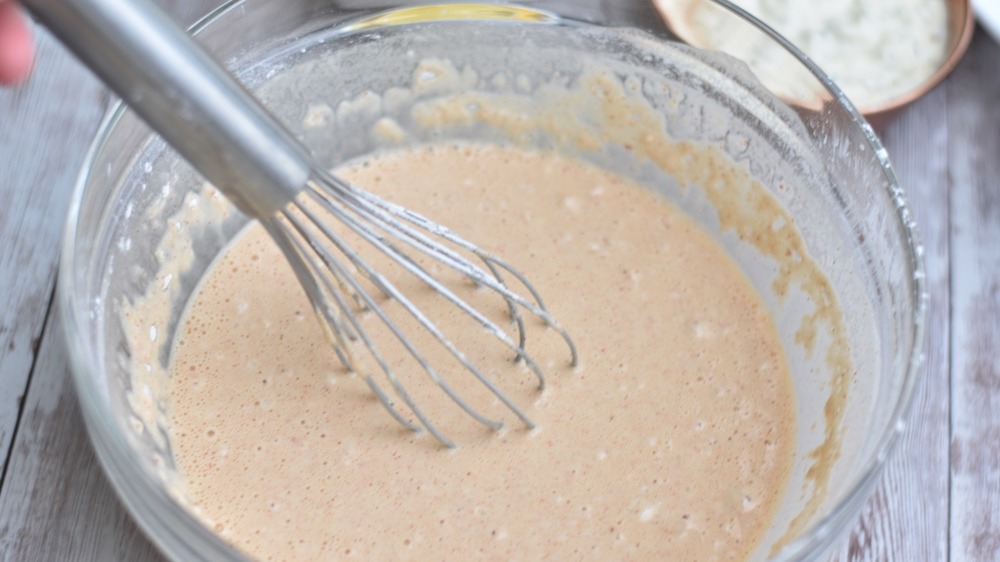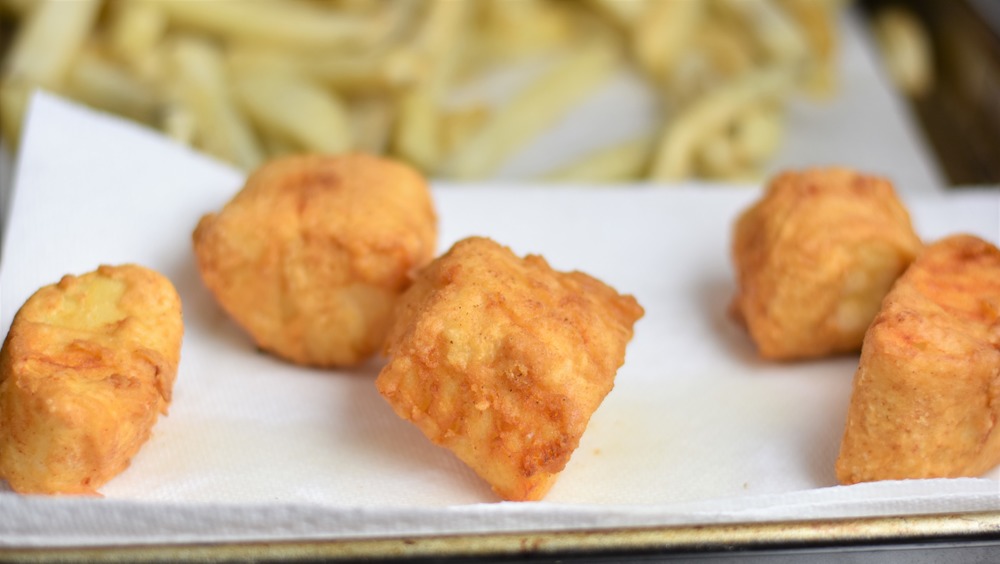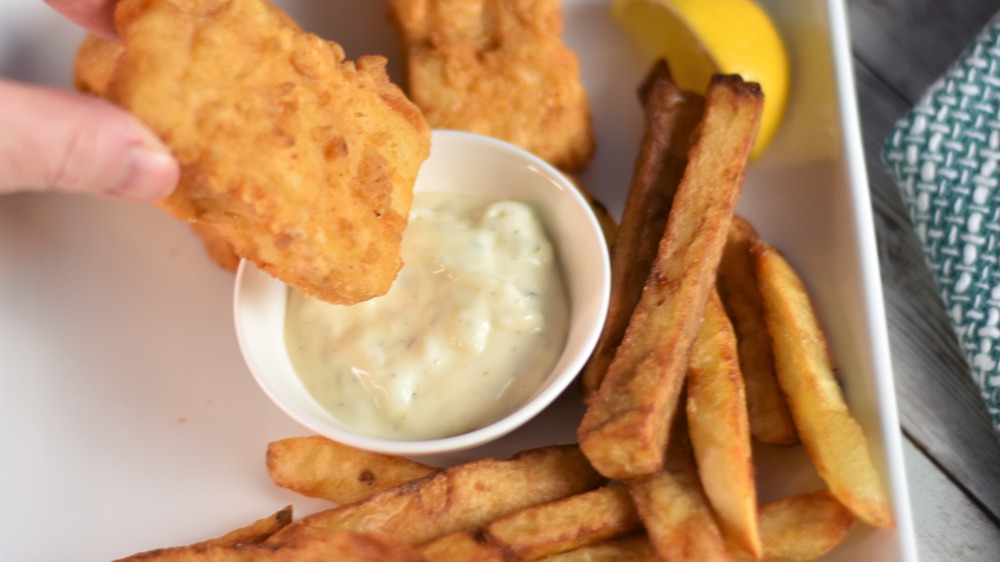Fish And Chips Recipe
"In the Midwest, especially Wisconsin and Illinois, Friday fish fry is huge during Lent and throughout the summer," says chef and recipe developer Stephanie Rapone of Pantry to Plate. "This really reminds me of those Fridays with my grandparents growing up." But here's a little secret for you: There's never a bad time for a great plate of fish and chips, be it a Friday during Lent, a Tuesday during August, or a Thursday in October.
The elegant simplicity of fish and chips has made it a staple dish enjoyed all over the globe. The meal is a crowd pleaser that even pickier eaters will enjoy, and once you have the breading down, it's really not a hard one to prepare, especially when you use Rapone's hack for the French fries (or chips, rather), which we'll get to below. Fish and chips is also a great dish because it pairs so easily with so much. You can serve it along with a chopped salad, cooked broccoli, succotash, and so much more.
One of Rapone's favorite pairing ideas for fish and chips harkens back to those Midwest childhood days: "It would often be served with coleslaw. I know that's not traditional English, but it's tasty and it's easy."
Gather your ingredients to make fish and chips
This is one of those recipes where how you handle the ingredients plays as big a role as the ingredients themselves. What you'll need to fry up a classic batch of fish and chips is four medium-large russet potatoes, two quarts (that's eight cups) plus a quarter cup of canola oil, a cup of flour, a cup of cornstarch, a teaspoon of paprika, three and a half teaspoons of iodized (table) salt, divided, a teaspoon of baking powder, one and a quarter cups cold beer (a light-colored beer works best here), two pounds of cod, and fresh lemon wedges. If you're looking for the perfect sauce, try tartar sauce, malt vinegar, or ketchup for dipping.
Prep the fish for your fish and chips
If you are using frozen cod for your fish and chips, make sure it is thawed completely, ideally by leaving it in the fridge for many hours before you start the prep. Cut the fish into pieces that are as even in size as possible. If you have pieces that are different thicknesses, just make sure to cook them in batches of similar size so they cook at the same rate.
Place the cod on a plate that's lined with paper towels. Place more paper towels on top and press down gently, then set aside. Let the excess water come out of the fish while doing the other prep. If the paper towels get soaked, switch them out to remove as much water as possible.
Prep and cook the fries for your fish and chips
Wash, peel, and cut the potatoes into quarter-inch fries, or go slightly larger. Rapone says, "I like to trim one side of the potato to make it flat, then cut into planks, then into fries." Now is it time to boil these cut fries? Oh no! "Microwaving the potatoes for the chips instead of boiling them is my hack!" says Rapone.
Place the cut fries in a large microwave-safe bowl, toss with a quarter cup of the canola oil, and then cover the bowl with plastic wrap (or use another microwave-safe container). Microwave on high power for four minutes, then carefully stir the fries with a spatula. Re-cover and microwave the fries for another two to four minutes until they are starting to become translucent and pliable but still have some resistance when you pierce them with a fork or pairing knife.
Carefully dump the potatoes in a large mesh strainer and rinse well under cold water. Spread them on a few kitchen towels to dry and come to room temperature while you continue with prep.
Continue cooking the fries and prep the batter for your fish and chips
Heat two quarts of oil in a large Dutch oven or pot over medium heat, making sure you have at least three inches of clearance from the top of the oil level to the top of the pot. If you have a clip-on candy or oil thermometer, that is the best tool to monitor the oil temp. Otherwise, you can check it with a digital probe thermometer.
While the oil is heating, line a large baking sheet with at least two layers of paper towels. Once the oil reaches 350 degrees Fahrenheit, carefully add the fries, using a spider or tongs, and increase the stove heat to high. Fry until the potatoes turn light golden brown, which will take about six to eight minutes, carefully stirring occasionally.
While the fries fry, whisk the flour, cornstarch, paprika, and two teaspoons of salt in a large mixing bowl until evenly combined. Scoop out three-quarters of a cup of this mixture and put it on a large rimmed baking sheet or in a 9x13-inch baking pan.
Next, add the baking powder to the remaining flour mixture in the mixing bowl and whisk to combine. Finally, transfer the fries to the paper towel-lined baking sheet, leaving some open space for the fish after it has fried.
Batter the fish for your fish and chips
Reduce the stove heat to medium-high, bringing the oil to 375 degrees.
Now, blot the excess moisture from the fish with paper towels, then set up a wire rack over a baking sheet. Season the fish lightly on both sides with a half teaspoon of salt. Next, carefully coat the fish in the dry flour mix on the sheet or pan, dusting off the extra, and then move it to the wire rack.
Now add a cup and a quarter of the beer to the flour mix that is still in the mixing bowl (the one that has the baking soda), and whisk until smooth. Use tongs to carefully dip each piece of fish in the batter, letting the excess drip off. Now, put the fish back into the dry mix and coat it. You can leave pieces resting on the baking sheet with the dry batter.
Note that Rapone advises you to "use dry paper towels to wipe the extra goop off the tongs. Do not rinse with water, as any water droplets that remain will splatter when you use the tongs to put the fish in the hot oil."
Fry the fish for your fish and chips
When the oil reaches 375 degrees, carefully add half the fish for your fish and chips using the tongs. "Carefully hold each piece of fish in the oil for 3 to 5 seconds before you let it go to let the batter set," advises Rapone.
Once half the fish is added to the pan, increase the heat to high. Fry for about four minutes, then turn each piece of cod and fry for three to four additional minutes until the pieces are golden brown. Transfer the fish to the paper towel-lined baking sheet with the fries and season these pieces with a quarter of a teaspoon of salt. Now, fry the other half of the fish in the same manner.
Crisp the fries and enjoy your fish and chips
Now, add all the fries back to the oil and fry until they are golden brown and crisp, or for about three to five minutes. While they are frying, add a fresh layer of paper towels to the baking sheet to absorb any excess grease.
When the fries are golden brown, remove them to the fresh paper towels and season with the remaining half teaspoon of salt.
Now, finally, give the fish a fresh squeeze of lemon juice over the fish and serve the dish with tartar sauce, malt vinegar, and ketchup.
Fish and chips directions
The elegant simplicity of fish and chips has made it a staple dish enjoyed all over the globe. The meal is a crowd pleaser that even pickier eaters will enjoy.
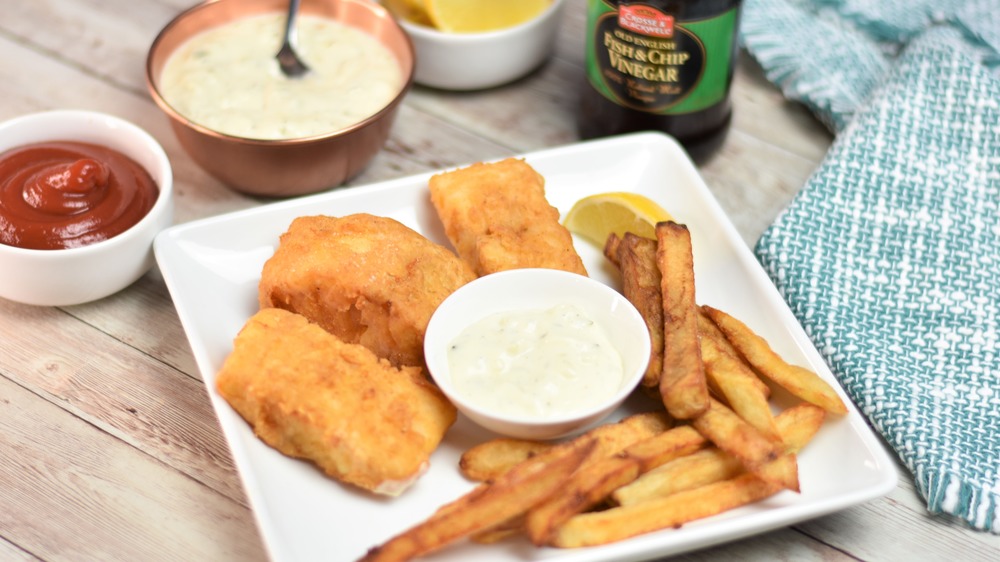
Ingredients
- 4 medium-large russet potatoes
- 2 quarts (8 cups) canola oil, plus 1/4 cup
- 1 cup flour
- 1 cup cornstarch
- 1 teaspoon paprika
- 3 ½ teaspoons iodized (table) salt, divided
- 1 teaspoon baking powder
- 1 ¼ cups cold beer (lager or other light-colored beer)
- 2 pounds cod
- Fresh lemon wedges
Optional Ingredients
- Tartar sauce, for dipping
- Malt vinegar, for dipping
- Ketchup, for dipping
Directions
- Cut cod into even-sized pieces, then place on a plate lined with paper towels. Place paper towels on top and press gently. Let the excess water come out of the fish while doing the other prep. If the paper towels get soaked, switch them out to remove as much water as possible.
- Wash, peel, and cut the potatoes into quarter-inch fries, then place them in a large microwave-safe bowl, toss with a quarter cup of the canola oil, and cover with plastic wrap (or other microwave-safe cover).
- Microwave on high power for 4 minutes, then carefully stir with a spatula. Re-cover and microwave for another 2 to 4 minutes until they are starting to become translucent and pliable but still have some resistance when you pierce them with a fork or pairing knife.
- Carefully dump the potatoes in a large mesh strainer and rinse well under cold water. Spread them on a few kitchen towels to allow them to dry and come to room temperature while you continue with prep.
- Whisk the flour, cornstarch, paprika, and 2 teaspoons salt in a large mixing bowl until evenly combined. Scoop out 3/4 cup of the mixture and put it on a large rimmed baking sheet or a 9x13-inch baking dish.
- In the remaining flour mixture in the mixing bowl, add the baking powder and whisk to combine.
- Heat 2 quarts of the oil in a large Dutch oven or pot over medium heat, making sure you have at least 3 inches clearance from the top of the oil level to the top of the pot. While the oil is heating, line a large baking sheet with at least two layers of paper towels.
- Once the oil reaches 350 degrees Fahrenheit, carefully add the fries using a spider or tongs and increase the stove heat to high and fry until the potatoes turn light golden brown, 6 to 8 minutes, carefully stirring occasionally.
- Transfer the fries to the paper towel-lined baking sheet, leaving some open space for the fish after it has fried.
- Reduce the stove heat to medium-high and heat the oil to 375 degrees, and while that's heating, blot the excess moisture from the fish with paper towels. Then, set up a wire rack over a baking sheet and season the fish lightly on both sides with ½ teaspoon salt. Then, carefully coat the fish in the dry flour mix, dusting off the extra and placing it on the wire rack.
- Add 1 ¼ cups (10 oz) of the beer to the flour mix that is still in the mixing bowl (the one that has the baking soda) and whisk until smooth.
- Use tongs to carefully dip each piece of fish in the batter, letting the excess drip off. Then, put the fish back into the dry mix and coat.
- When the oil reaches 375 degrees, carefully add half the fish using the tongs. Carefully hold each piece of fish in the oil for 3 to 5 seconds before you let it go to let the batter set.
- Once half the fish is added to the pan, increase heat to high. Fry for about 4 minutes, then turn over and fry for 3 to 4 additional minutes, until golden brown.
- Transfer fish to the paper towel-lined baking sheet with the fries. Season with ¼ teaspoon salt. Fry the other half, seasoning with the remaining ¼ teaspoon salt at the end.
- Once the fish is done frying, return the oil to 375 degrees, then add all the fries back to the oil and fry until golden brown and crisp, 3 to 5 minutes.
- While they are frying, add a fresh layer of paper towels to the baking sheet to absorb any excess grease.
- When the fries are golden brown, remove them to the fresh paper towels and season with the remaining ½ teaspoon salt.
- Give the fish a fresh squeeze of lemon and serve with tartar sauce, malt vinegar, and ketchup.
